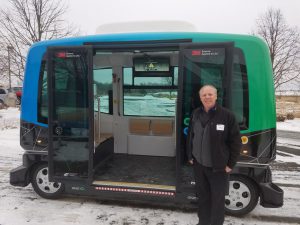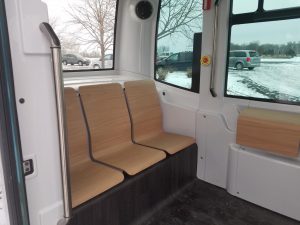
Whether we’re ready or not, autonomous vehicles are becoming less like fictional stories and more versed into our reality. Although Minnesota doesn’t currently have driverless vehicles on its roadways, MnDOT is actively working on a pilot project to prepare for this future mode of transportation when it arrives.
Earlier this year, Roger Walz, Egan Company Technology Systems Manager, was invited to participate in this pilot project. As the current President of Intelligent Transportation Systems (ITS) of Minnesota, Walz was among 11 other people invited to take the driverless vehicle for a ride.
This particular driverless shuttle was fully electric, held up to 12 passengers (six seated and six standing), had no steering wheel, and operated based on pre-mapped lidar and GPS guided routes. Pedal to the metal it could drive at 25mph and was fully equipped with sensors to stop when a person or object was in front of it – which was demonstrated to the group.
The goal for the group was to simply experience the vehicle, provide feedback, and ask questions. This particular phase of the pilot project was to test and monitor the technology during the cold, wintry conditions of Minnesota.
“Before MnDOT can bring autonomous technology to the Twin Cities, many things would need to change,” said Walz. “And, the biggest changes would be within our roadway infrastructure.” 
Adopting driverless technology implies that the current technology within our roadway infrastructure would need to be compatible to move these vehicles. Everything from roadway lighting, traffic signals, fiber optic signage, loop detectors, parking ramps, and so much more would need to function with this technology.
“The hope is that Egan’s role could include an opportunity to furnish and install this electrical- and technology-based infrastructure,” said Walz. “As a company, we’ve always demonstrated an innovative, proactive attitude to embrace new technology and adapt with our marketplace.”
Nonetheless, it’s exciting to think about and consider where this technology will literally take us in the future. The possibilities are boundless. But, in the meantime, our regular vehicles will still be needed to get us from point A to point B.
